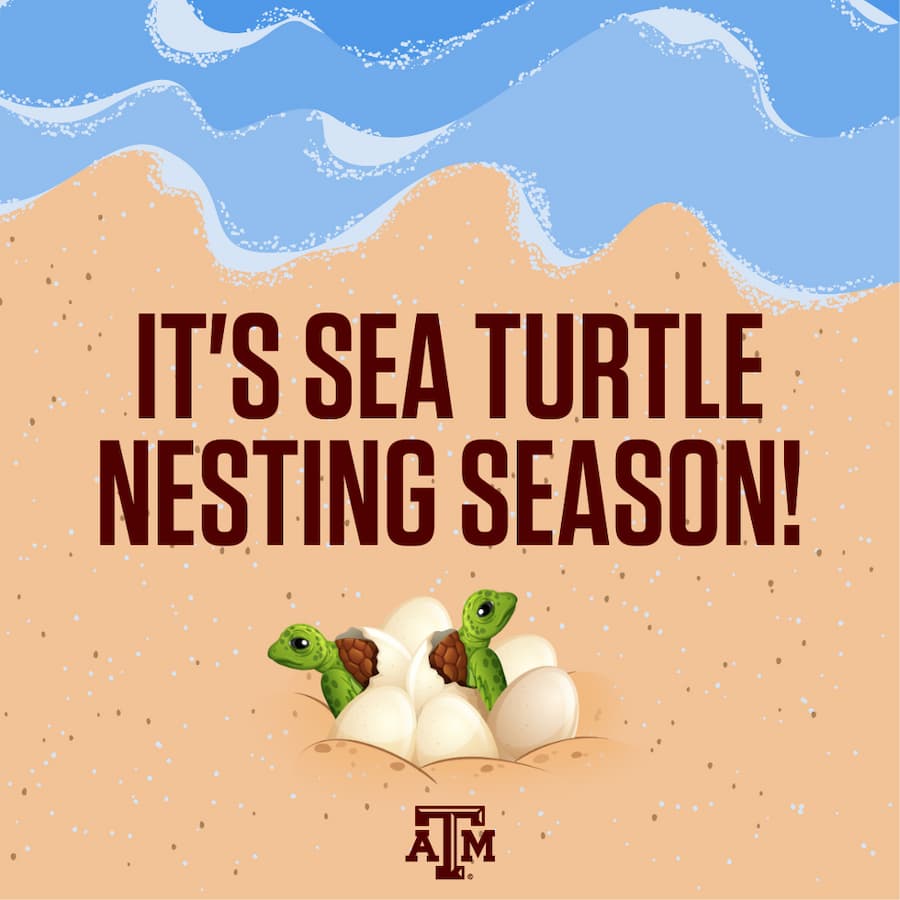Sea Turtle Nesting Season is Here

Sea turtle nesting season is upon us! In Texas, sea turtles nest from April through July. Three kinds of sea turtles are commonly found in Texas waters: Kemp’s Ridley, Green and Loggerhead. Kemp’s Ridley turtles, the world’s most endangered sea turtle, nest in the western Gulf of Mexico.
Each season, the Sea Aggie Turtle Patrol finds about a dozen nests on the upper Texas coast. With 87 miles of beach to monitor during nesting season, this is a massive conservation effort and a huge undertaking for this group made up primarily of volunteers.
“We ask that everyone do their part in protecting sea turtles,” said Theresa Morris, program assistant for the Gulf Center for Sea Turtle Research. “Keep an eye out for sea turtle tracks, if you’re driving on the beach drive carefully, keep your distance if you see a turtle or a nest and be sure to call 1-866-TURTLE-5 to report it.”
Galveston Island and the surrounding area is the northernmost range for the Kemp’s ridley; conservation efforts for the species are critical. Sea turtles usually lay between 100 to 110 eggs in each clutch and will come back to nest multiple times in a season. Though that might sound like a lot, only about one tenth of a percent of the eggs will reach adulthood.
While the Gulf Center for Sea Turtle Research (GCSTR) has some capacity for sea turtle rehabilitation, hopes are high that the upper Texas coast will soon have a rehabilitation facility that is fully equipped to handle the needs of local sea turtles. The start of turtle nesting season reinforces this necessity. The facility would have a hospital as well as an educational center where guests could see sea turtles up close.
Morris told bldg. 311, “Although the Kemp’s ridley sea turtles are still the most critically endangered species, these efforts have driven up their population and protect other species of sea turtles as well.” The support of the local community and tourists alike is vital–so what can you do? Beachgoers can help spot and report sea turtle nests. Call 1-866-TURTLE-5, the Texas sea turtle hotline, if you see a sea turtle in trouble or spot a nest. Sea turtles are a protected species by the United States government, so you shouldn’t handle sea turtles without permission to do so. This hotline and the monitoring done by Texas A&M at Galveston students gives injured or sick turtles a chance to be rehabilitated, protects nests and allows for the collection of important biological data to help conservation efforts for this endangered species.
You can also support sea turtles and GCSTR by donating your time or money.
Donate directly to the Gulf Center for Sea Turtle Research online.
The Sea Turtle Rescue Team responds to any sick, injured, entangled, or dead sea turtle that strands along the upper Texas coast. Before applying, please keep in mind that sea turtles are federally protected species and these activities require training and permitting. Apply to volunteer.
Media Contact
Taylor Bounds
bounds@tamug.edu
409-740-4929